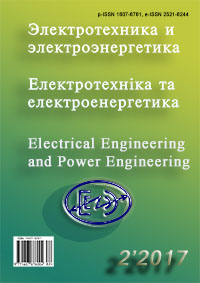NUMERICAL WITHOUT ITERATION METHOD OF MODELING OF ELECTROMECHANICAL PROCESSES IN ASYNCHRONOUS ENGINES
DOI:
https://doi.org/10.15588/1607-6761-2017-2-5Keywords:
electromechanics processes, asynchronous engines, numeral methods, differential equationsAbstract
Purpose. Development of calculation of electromagnetic and electromechanic transients is in asynchronous engines without iterations.
Methodology. Numeral methods of integration of usual differential equations, programming.
Findings. As the system of equations, describing the dynamics of asynchronous engine, contents the products of rotor and stator currents and product of rotation frequency of rotor and currents, so this system is nonlinear one. The numeral solution of nonlinear differential equations supposes an iteration process on every step of integration. Time-continuing and badly converging iteration process may be the reason of calculation slowing. The improvement of numeral method by the way of an iteration process removing is offered. As result the modeling time is reduced. The improved numeral method is applied for integration of differential equations, describing the dynamics of asynchronous engine.
Originality. The improvement of numeral method allowing to execute numeral integrations of differential equations containing product of functions is offered, that allows to avoid an iteration process on every step of integration and shorten modeling time.
Practical value. On the basis of the offered methodology the universal program of modeling of electromechanics processes in asynchronous engines could be developed as taking advantage on fast-acting.
References
Pivnyak, G. G., Vinoslavskiy, V. N. (2003). Perekhodnyye protsessy v sistemakh elektrosnabzheniya. Moscow, Energoatomizdat, 548. (in Russian)
Venikov, V. A. (1985). Perekhodnyye elektromekhanicheskiye protsessy v elektricheskikh sistemakh. Moscow, Vysshaya shkola, 536. (in Russian)
Yarymbash, D. (2012). Features of the short-circuit current calculations of the ac graphitization power electrical complex. Electrical Engineering And Power Engineering, 1, 23-30. DOI: 10.15588/1607-6761-2012-1-6. (in Russian)
Yarymbash, D. (2014). The features of the calculation of electrodynamic stability of laminated bus packages of low-voltage circuit of graphitization furnace. Visnyk SevNTU: Seriya: Mekhanika. Enerhetyka. Ekolohiya. 146, 131-136. (in Russian)
Kotsur, M. (2014). Features of the of thermal effect impact on the asynchronous motor with the modified pulse control system in conditions of frequent starts. Electrical Engineering And Power Engineering, 1, 32-36. DOI: 10.15588/1607-6761-2014-1-5
Kopylov, I. P. (2001). Matematicheskoye modelirovaniye elektricheskikh mashin. Moscow, Vysshaya shkola, 327. (in Russian)
Vaskovskiy, Yu. V., Geraskin, A. A. (2012) Mathematical modeling of electromagnetic fields in the squirrel cage induction motor with damaged rotor winding, Tehnicheskaya elektrodinamika, 2. 56 – 61. (in Russian)
Milyih, V. I., Polyakova, N. V. (2013) An analysis of harmonic composition the AC magnetic field associated with a rotating rotor turbine generator, at idle speed and short circuit modes, Electrical Engineering And Power Engineering, 2. 5–12. DOI: 10.15588/1607-6761-2013-2-1 (in Russian)
Mogilnikov, B. C., Oleynikov, A. M., Strelnikov, A. N. (1983) Asinhronnyie dvigateli s dvuhsloynyim rotorom i ih primenenie, Moscow, Energoatomizdat, 120. (in Russian)
Plyugin, V. E. (2013) Numerical simulation of the electromagnetic field of the induction motor with the external massive rotor, Vestnik NTU «KHPI», 51(1024), 66 – 75. (in Russian)
Yarymbash, D., Kotsur, M., Yarymbash, S., & Kotsur, I. (2017). Features of parameter determination of the induction motor substitution circuit for short-circuit mode. Electrical Engineering And Power Engineering, 1, 24-30. DOI: 10.15588/1607-6761-2017-1-4. (in Russian)
Yarymbash, D., Kotsur, M., Yarymbash, S., & Kotsur, I. (2016). Features of three-dimensional simulation of the electromagnetic fields of the asynchronous motors. Electrical Engineering And Power Engineering, 2, 43-50. DOI: 10.15588/1607-6761-2016-2-5. (in Russian)
Pustovetov, M. Kompyuternoye modelirovaniye asinkhronnikh dvigateley i transformatorov / M. Pustovetov. K. Solus. I. Sinyavskiy.- LAP LAMBERT.- 2013.- 206 c. (in Russian)
Persova, М. G., Soloveychik, Yu. G., Temlyakova, Z. S. (2007) A new approach to the design of electrical machines based on numerical simulation, Elektrotehnika, 9, 15–21. (in Russian)
Makeyev, M. S., Kuvshinov, A. A. (2013). Algorithm for calculating the parameters of the equivalent circuit of the asynchronous engine at the catalog data. Vektor nauki TGU, 1 (23), 108-112. (in Russian)
Moshchinskiy, Yu. A., Bespalov, V. Ya., Kiryakin, A. A. (1998). Ascertainment of the equivalent circuit parameters of the asynchronous machine at the catalog data. Elektrichestvo, 4/98, 38-42 (in Russian)
Keoun, D. (2008). OrCAD Pspice. Analiz elektricheskikh tsepey. sPb,: Piter. 640. (in Russian)
Yarymbash, S., Kylymnyk, I., & Yarymbash, D. (2010). Specific determination of equivalent circuit parameters in the furnace loop of the AC graphitizing furnace. Electrical Engineering And Power Engineering, 2, 36-43. DOI: 10.15588/1607-6761-2010-2-6. (in Russian)
GNU Octave [online] Available at: www.gnu.org/software/octave/index.html
Chernykh, I. V. (2008). Modelirovaniye elektrotekhnicheskikh ustroystv v MATLAB, SimPower Systems i Simulink. Moscow, DMK Press,.288. (in Russian)
Downloads
Published
How to Cite
Issue
Section
License
Copyright (c) 2018 D. Patalakh, S. Tykhovod, T. Kornus

This work is licensed under a Creative Commons Attribution 4.0 International License.
Creative Commons Licensing Notifications in the Copyright Notices
Authors who publish with this journal agree to the following terms:
Authors retain copyright and grant the journal right of first publication with the work simultaneously licensed under aCreative Commons Attribution License that allows others to share the work with an acknowledgement of the work's authorship and initial publication in this journal.
Authors are able to enter into separate, additional contractual arrangements for the non-exclusive distribution of the journal's published version of the work (e.g., post it to an institutional repository or publish it in a book), with an acknowledgement of its initial publication in this journal.
Authors are permitted and encouraged to post their work online (e.g., in institutional repositories or on their website) prior to and during the submission process, as it can lead to productive exchanges, as well as earlier and greater citation of published work.

